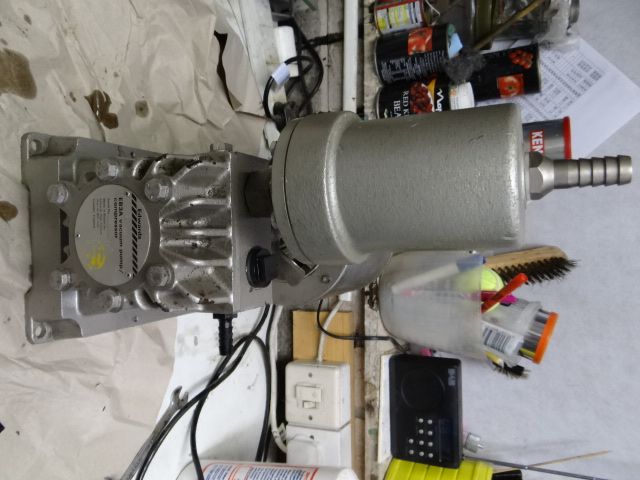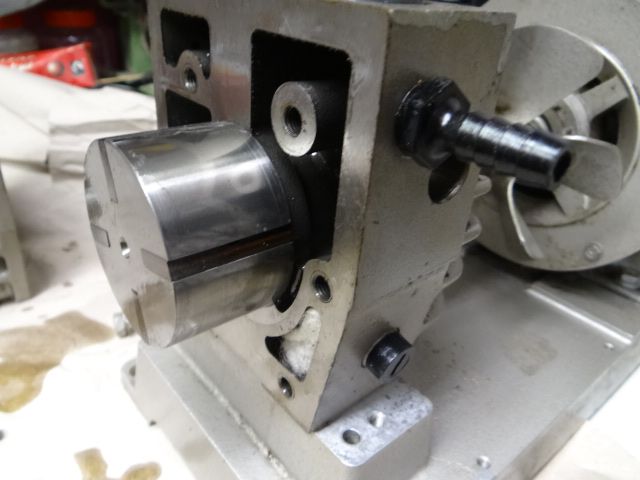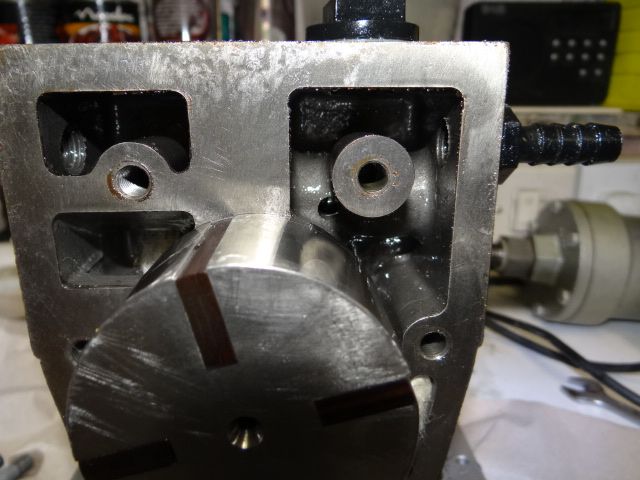Vacuum Pump Advice Please!
| SillyOldDuffer | 24/09/2020 16:55:32 |
| 10668 forum posts 2415 photos | Another fine mess I've got myself into. I'm building a clock (which doesn't work yet) intending to run the pendulum in a vacuum. Years ago I bought an Edwards 3B vacuum/compressor from a nice man at a car boot sale who assured me it was a high-vacuum pump. Was he a naughty fibber? Got it home, fired it up for a quick test, seemed to work but not good today. The motor runs but the compression and vacuum fail to impress. No manual or info on the web. Suspected it needed oil and have the right sort. Sprayed myself & workshop, I think by filling the pump through the wrong hole at the top. Fortunately the big output filter was off and the oil came out without fuss. On second thoughts this type of pump may be medical, and not meant to be oily. Opening it up revealed a rotor with four fibre vanes running in an offset circle - a vane pump. The black nozzle top right photo above is for the vacuum hose. Below near the base is a plastic screw screw cap covering a felt pad with access to a chamber filled with coarse fibre: could be a filter, or an oil pad. Anyone know if this is the oiling point? The pump would have to be tipped sideways to use it. Just underneath and to the right of the black vacuum connector is a big spring loaded slotted steel screw ending in a rod fitting into a hole. It probably communicates with the vacuum side - see below. I think it's a valve of some sort. Anyone know what it is? The vanes don't seem worn and there's no physical damage inside to speak of. As the pump is covered in cooling fins and has a 500W continuous motor I was expecting a more powerful vacuum and better compression. Have I bought the wrong pump and am I expecting too much? All help and suggestions gratefully received! Ta, Dave
Edited By SillyOldDuffer on 24/09/2020 16:55:53 |
| Oven Man | 24/09/2020 17:25:15 |
204 forum posts 37 photos | Dave Are the vanes free to move in and out? They might be spring loaded or move out under centrifugal force. Peter |
| Dave Halford | 24/09/2020 17:29:49 |
| 2536 forum posts 24 photos | You've not said the vanes are free to move? beaten to it Below near the base is a plastic screw screw cap covering a felt pad with access to a chamber filled with coarse fibre: could be a filter, or an oil pad. Anyone know if this is the oiling point? This sounds like to be an oil trap for the bearing breather, perhaps to stop it pumping all the oil out. It's a lab pump link Edited By Dave Halford on 24/09/2020 17:30:16 |
| Ian Parkin | 24/09/2020 17:33:52 |
1174 forum posts 303 photos | I do deal with a lot of pumps like this in the print industry and never considered them to be high vacuum usually the ones i work with are dry with carbon vanes older ones were steel bladed running with oil and an oil separator a bit like a hydro vane pump anyway check that the vanes are free to slide in and out and don’t expect much of a vacuum with it.. |
| SillyOldDuffer | 24/09/2020 18:27:07 |
| 10668 forum posts 2415 photos | Oh dear, not to expect too much of it - the worst answer! The vanes slide in and out freely - no springs. The construction doesn't seem to provide much of a seal at the ends which implies low compression. Could be it's a dental spit sucker, designed to run continually without enough power to disembowel anyone! Got a vacuum gauge and a pressure either of which would show how good or bad it is - both are Absent With Out Leave.
Dave
|
| Martin Cargill | 24/09/2020 18:49:07 |
| 203 forum posts | It looks like a dry pump, As Ian Parkin mentioned the oil pumps tend to have steel vanes. The vanes you have should be free to move in their slots. The Felt pad etc is probably a filter to remove worn vane debris from being blown out by the pump. The slotted screw is probably a vacuum valve (the reverse of a pressure valve) to stop it drawing too much vacuum .
Martin |
| Ian Parkin | 24/09/2020 19:15:16 |
1174 forum posts 303 photos | I’m sure that the fibre vanes need lubing small offset machines used to have “Gast “ pumps which had fibre vanes and a small (50ml) glass jar on the inlet side with a pipe cleaner into the oil and inlet to lube the vanes |
| Steviegtr | 24/09/2020 19:28:21 |
2668 forum posts 352 photos | The ones i used to PAT test in labs looked like that. The more powerful types i would have thought, would be the ones used to vac down air conditioning units to remove moisture. Steve. |
| Roger Hart | 24/09/2020 19:35:11 |
| 157 forum posts 31 photos | looks a decent pump, if a bit small. Should get to about 1mm mercury on a small tight chamber. On the inlet side the vanes sweep oil+air round and compress the air to be exhausted. There is no valve on the inlet side. On the outlet side there is usually some sort of reed valve. The old slow pumps had a neoprene flap, I have seen a steel reed valve on faster pumps. These sometimes break and don't work. There is sometimes a bleed valve to let air into the pump on the inlet side to help degas the oil and 'give something to chew on'. Usually this can be screwed up tight shut. The vanes run immersed in oil but not too much - say 3/4 full. Ordinary 20/50 oil works OK, Edwards oil v pricey. The drive shaft sometimes has a simple oil pump - waggling rod in off centre groove to pump bearing oil. Take care to put this back right. Otherwise, if the vanes are not stuck there is not much to go wrong. Gaskets not usually used but some older pumps used a lick of shellac on the mating faces. Slightly worried about running a clock in a vacuum chamber, outgassing etc. Not at all easy to get a really good seal, not really a vac once and forget job. Still - enjoy. As said in ATM books, high vacuum is a technique that makes figuring mirrors look easy - and I agree! True high vacuum is in the 10^-5 and beyond region, think turbo pumps etc.
|
| Bill Davies 2 | 24/09/2020 19:37:54 |
| 357 forum posts 13 photos | Do you need a 'high' vacuum Dave. The vacuum pump I used as a school technician would remove enough air that a buzzerl was all but silent, but would be nothing like the vacuum required for making bulbs, electronic valves (tubes), sputter aluminium onto mirrors or the like. I can't recall the pressure that it went down to, but a surprising amount of air had to leak back into the bell jar when the valve to the atmosphere was opened. Bill |
| Robert Atkinson 2 | 24/09/2020 19:53:34 |
1891 forum posts 37 photos | The EB3A is classed as a high vacuum but i't's relative. Specification seems to be 26" Hg / 133mB. So pretty good. Certainly good enough for a pendulum enclosure. It's not an oil free pump but is not wet/oil sealled. The wet ones have a "sump" cover over the pump block with a level glass. The Black plastic "cheese head" screw is normally the oil filler on Edwards pumps. Was the wadding wet with oil? If so it likely that is the oil filler. Most likely issue is leacking or stuck valves. These will be poppet or reed (possibly combination) type. Robert G8RPI. |
| Robert Atkinson 2 | 24/09/2020 19:58:16 |
1891 forum posts 37 photos | I crossed with Rodgers post. His description is correct for the wet vacuum pumps like the speedi-vac and EV range. As the EB3A will also act as a compressor I'd expect it to have valve on inlet and outlet but I've never had one apart. Robert G8RPI. |
| John Haine | 24/09/2020 20:41:04 |
| 5563 forum posts 322 photos | According to Wikipedia the Shortt free pendulum tank was evacuated to 30mm mercury - ~39 mBar. In 1984 Pierre Boucheron did some measurements of the stability of a Shortt pendulum electronically impulsed using one preserved at NIST in Colorado. Apparently the tank vacuum was intact after something like 30 years. Edited By John Haine on 24/09/2020 20:49:30 Edited By John Haine on 24/09/2020 20:51:58 |
| old mart | 24/09/2020 21:16:37 |
| 4655 forum posts 304 photos | That Edwards pump is capable of going down to 133mB, which may not be enough for your requirements. |
| John Haine | 24/09/2020 21:53:24 |
| 5563 forum posts 322 photos | Depends on the requirement. The Shortt ran at very low pressure to maximise Q, but even at lower vacuum the Q increase will be worthwhile and it should eliminate barometric rate variations. |
| SillyOldDuffer | 26/09/2020 18:49:23 |
| 10668 forum posts 2415 photos | Pleased to report the pump is much better. Took it apart again and went over it carefully. There are no valves. I believe the improvement is down to putting oil in the right place. Not just a lubricant, I believe it's part of the sealing system. When the pump is running I think oil is pulled out of the padded reservoir and into the gap between the cylinder end and the rotor block where it fills the gaps and makes it difficult for air to leak past the rotor blades. I cleaned a thin layer of caramelised oil off the end-face that may have stopped oil flowing into the gap properly. Anyway, the pump now pulls a markedly stronger vacuum on a rigid cylinder. Wish I could find the missing gauge to see how good or bad it is! Dave
|
| not done it yet | 26/09/2020 19:45:44 |
| 7517 forum posts 20 photos | I had two speedivac pumps in the back of my car this last week. One turns, the other doesn’t, at the moment. One will get sold, if it works, and the other will certainly go for scrap if it won’t free off (they are heavy). You could have it if you were local... I have one in operating condition that I have used for degassing wines. It pulls a hard vacuum.🙂 |
Please login to post a reply.
Want the latest issue of Model Engineer or Model Engineers' Workshop? Use our magazine locator links to find your nearest stockist!
Sign up to our newsletter and get a free digital issue.
You can unsubscribe at anytime. View our privacy policy at www.mortons.co.uk/privacy
- *Oct 2023: FORUM MIGRATION TIMELINE*
05/10/2023 07:57:11 - Making ER11 collet chuck
05/10/2023 07:56:24 - What did you do today? 2023
05/10/2023 07:25:01 - Orrery
05/10/2023 06:00:41 - Wera hand-tools
05/10/2023 05:47:07 - New member
05/10/2023 04:40:11 - Problems with external pot on at1 vfd
05/10/2023 00:06:32 - Drain plug
04/10/2023 23:36:17 - digi phase converter for 10 machines.....
04/10/2023 23:13:48 - Winter Storage Of Locomotives
04/10/2023 21:02:11 - More Latest Posts...
- View All Topics
- Reeves** - Rebuilt Royal Scot by Martin Evans
by John Broughton
£300.00 - BRITANNIA 5" GAUGE James Perrier
by Jon Seabright 1
£2,500.00 - Drill Grinder - for restoration
by Nigel Graham 2
£0.00 - WARCO WM18 MILLING MACHINE
by Alex Chudley
£1,200.00 - MYFORD SUPER 7 LATHE
by Alex Chudley
£2,000.00 - More "For Sale" Ads...
- D1-3 backplate
by Michael Horley
Price Not Specified - fixed steady for a Colchester bantam mark1 800
by George Jervis
Price Not Specified - lbsc pansy
by JACK SIDEBOTHAM
Price Not Specified - Pratt Burnerd multifit chuck key.
by Tim Riome
Price Not Specified - BANDSAW BLADE WELDER
by HUGH
Price Not Specified - More "Wanted" Ads...
Do you want to contact the Model Engineer and Model Engineers' Workshop team?
You can contact us by phone, mail or email about the magazines including becoming a contributor, submitting reader's letters or making queries about articles. You can also get in touch about this website, advertising or other general issues.
Click THIS LINK for full contact details.
For subscription issues please see THIS LINK.
Model Engineer Magazine
- Percival Marshall
- M.E. History
- LittleLEC
- M.E. Clock
ME Workshop
- An Adcock
- & Shipley
- Horizontal
- Mill
Subscribe Now
- Great savings
- Delivered to your door
Pre-order your copy!
- Delivered to your doorstep!
- Free UK delivery!















 Register
Register Log-in
Log-in


